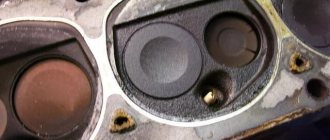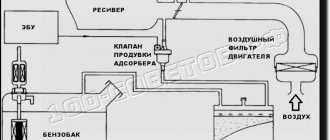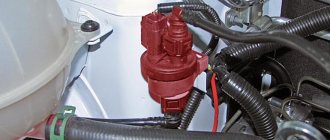Timing valves are located directly in the combustion chamber and are designed for high temperature loads. However, if the normal operation of internal combustion engines is disrupted, even the heat-resistant material from which they are made is destroyed over time. How quickly the valves burn out depends on the nature of the problem. Typical signs that a valve in a cylinder has burned out are rough operation and difficulty starting the engine, as well as loss of power. However, these same symptoms can also occur with other problems. This article will help you understand what a “burnt valve” means, why this happened and learn about ways to diagnose the timing belt without removing the head.
Signs of burnt valves. Low compression in the cylinder. Replacing valves
Modern engines are equipped with a complex valve system. In addition to being a complex design, it is also highly precise, but this in no way protects the valves from damage. Unfortunately, burnt valves are a fairly common problem for both gasoline and diesel power units.
Signs of burnt valves can be observed not only on old engines, but also on relatively fresh ones. It is impossible to operate an engine with a burnt-out valve, and therefore it will be useful for novice motorists to find out where this problem comes from, what to do in this case, what are the symptoms of this problem.
Why do valves burn out?
In fact, there are many reasons. For those engines where the manufacturer recommended periodic valve adjustment, this problem occurs due to the incorrect adjustment of the thermal clearances. On engines where the clearance adjustment process is performed automatically, hydraulic compensators may fail - as a result, the valve simply burns out.
There are several most popular reasons, the result of which is the same - the valve has burned out. So, the first reason is that the parts are very tightly clamped. Next, the valve guide is in a state of severe wear. It is also common to see wear on the rod. And one more reason is that the engine runs on a lean mixture; owners of gas-powered cars especially often face the problem of burnout. Most often, exhaust elements burn out. They heat up to significantly higher temperatures than the intake ones. The intake valve is cooled during operation by a mixture of fuel and air.
The operating temperatures of the exhaust elements are about 400 degrees. This valve, unlike the intake valve, is not cooled in any way; in addition, it is additionally heated due to exhaust gases. Next, these valves are heated to approximately 650 degrees.
Causes
There are several reasons why valves can burn out:
- Manufacturing defects. The likelihood of deviations from the norm during the production of components is small, but still exists. Heterogeneity of the metal, defects in welding seams, microcracks are the first signs of defects.
- Critical temperatures. The operating temperature of the valves fluctuates around 650 °C. If the heat dissipation system is faulty, excessive overheating will cause the metal to quickly deteriorate.
- Poor quality gasoline. A lean fuel mixture leads to temperature spikes, which is even more damaging to the valves.
- Gas. Gas-powered engines are subject to greater loads than gasoline engines. Especially if the car is set to low gas supply. It is recommended to calibrate the valves every 10 - 15 thousand km.
A high percentage of defective spare parts is a problem for the motorist
These are not the main reasons why valves burn out. The leading manufacturer of these parts conducted a small study, and the statistics were not happy - every fifth part that is produced breaks or burns out due to the human factor and defects. And even modern product quality control at factories does not guarantee that the part is free of any defects.
Another reason is metallurgical inhomogeneities that are included in the alloy. These irregularities make the valve weaker than it should be. In addition, there are manufacturing defects, namely forging. This leads to microcracks. Errors in the heat treatment process lead to changes in the dimensions of the product.
Consequences of burnout
If a valve burns out, it may immediately collapse. Its fragments will definitely fall into the combustion chamber. As a result, the engine will suffer serious damage and will require major repairs. Thus, the pistons, cylinder head and cylinder block are severely damaged. There is also a serious risk that large pieces of a destroyed, burnt-out valve will simply pierce the cylinder block, and this will actually lead to failure of not only the piston group and cylinder head parts, but also the cylinder block.
You should not operate an engine that exhibits symptoms of a burnt valve. This is fraught with high repair costs, and in the worst case, replacement of the entire motor. It is better to notice the problem in a timely manner, and then the only consequences are replacement of the valves. The consequences of operating a car with a burnt-out valve can be different - from significantly increased fuel consumption to a completely burnt-out valve seat.
Subsequent repairs
If fears about burnt-out parts of the gas distribution system are confirmed, then it is necessary to send the car for repairs. It is important to eliminate the reasons why the breakdown occurred, otherwise it will quickly return after repair.
Incorrect adjustment may be the culprit, so after installing the spare parts it is important to pay sufficient attention to the clearance settings. For modern cars, you will also have to purchase new hydraulic compensators, which will probably fail.
It is important to check the condition of the springs (they may be weakened) and check the bushings (the guides may have significant wear). It is advisable to purchase products from trusted manufacturers that will last a long time and be of high quality.
We recommend switching to high-quality fuel and not refueling in dubious places. This will help avoid problems in the future.
Symptoms of the problem
So, the main signs of burnt-out valves are engine tripping. This effect is very noticeable and can be observed in any operating mode of the power unit. In addition, the motor loses a lot of power. Another reason is high fuel consumption.
There are certain difficulties in diagnosing this breakdown. The fact is that if a valve burns out, the symptoms are very similar to other malfunctions. At the same time, the car owner will be sure until the last moment that this is just another, minor breakdown. These are unnecessary costs and actions.
Video on the topic
Burnout of valves is one of the quite common car engine malfunctions. Both intake and exhaust valves can burn out. In this case, to one degree or another, part of the working surface of the valve disc is destroyed.
Signs of valve burnout
— The engine “troits” at idle.
— Slamming exhaust gases coming out of the muffler.
— Increased fuel consumption.
— Deterioration of vehicle dynamics.
At the same time, engine power and throttle response are greatly reduced.
It should be taken into account that similar symptoms are possible if there is a malfunction of the ignition system (spark plugs, armored wires, coil, distributor, etc.) or the power system (nozzles, carburetor needle valve, fuel pump). For more details, see “Engine troubles, reasons.”
the working surface of the valve disc is most often subject to destruction (burnout)
Causes of valve burnout
— Long-term driving on a lean fuel mixture.
— Long-term operation of the car with late ignition.
Function of valves in an engine
The valve in the motor plays an important role. This part allows the fuel-air mixture to enter the cylinders. In addition, the valves are responsible for the release of exhaust gases after the end of the cycle. The element constantly works in very difficult, even aggressive conditions. They are constantly exposed to high temperatures and gases. Over time, the metal of the part breaks down and burns.
Especially often, signs of burnt valves can be observed on old car models, the engine parts of which are made of far from high-quality materials. Most people create these troubles for themselves. Often the engine runs on low-quality fuel and sometimes not even intended for a specific unit. As a result, higher combustion temperatures lead to damage and destruction of the cylinder head.
Why is adjustment necessary?
The correct procedure depends on:
- uninterrupted operation of the LADA Kalina engine (operation with a reduced noise level in the timing belt, no errors in the camshaft sensor);
- reduction of fuel consumption to a level close to that regulated by the manufacturer;
- less wear on the camshaft cams and the pushers interacting with them.
- cleanliness of combustion chambers and valve plates due to the absence of carbon deposits.
Valve adjustment in a Lada Kalina car should be carried out with a periodic mileage of 20 thousand km or a little more.
It is not recommended to neglect this procedure, since the regulatory value of the gaps at the valves of the intake and exhaust circuits changes. This circumstance provokes a loose fit of the valve discs to the seat seats, which inevitably leads to the formation of carbon deposits, incomplete combustion of fuel, damage to the discs with subsequent burnout and other troubles in the timing belt in the LADA Kalina model. As you can see, in the absence of the required clearances, there is a violation of the correct functioning of the engine as a whole, and the only harmless point here is the owner’s acoustic discomfort due to the increased noise of the timing belt.
Note that adjustment of the valve mechanism requires 8 valve engines of Lada Kalina cars.
Difficulties in diagnosis
There is an opinion that if a valve burns out, symptoms and problems will be hidden in the ignition system. Very often, car mechanics, who still have little work experience, first of all begin diagnosing and repairing the ignition.
In the process of such repairs, the distributor cover is replaced, high-voltage wires and spark plugs are replaced. The ignition angle is also set - of course, there is no result and there will not be one. The engine has worked and will continue to work. The car mechanic will continue to look for the problem, not knowing the true cause of the problem. Even those mechanics who guessed that the problem lies in the engine see signs of burnt valves only after removing the cylinder head.
Diagnosis of valve burnout without removing the cylinder head
The first step is to identify the cylinder that is not functioning. Testing methods are similar to the process of diagnosing non-functioning spark plugs. For the test, start the engine and remove the spark plug caps while idling.
Next, you need to carefully monitor how the motor operates. If the unit starts up even more than before the test, or even stalls completely, then everything is fine with this cylinder. However, if the engine's performance has not changed, this indicates a problem in the cylinder.
After this, the spark plug on the found cylinder is unscrewed and replaced with a known working one. It would also be a good idea to check the high-voltage wire going to it. Additionally, check the ignition coil. Further starting the engine will show where the problem is hidden. If the engine, after replacing the spark plug and other parts, does not change its operation and continues to run, there is a high probability that the valve has burnt out.
How to determine a bad cylinder?
The essence of the simplest test comes down to sequential shutdown of the cylinders. By simulating a malfunction, we observe changes in engine operation. After turning off the boiler in which the valve has burned out, changes in operation will be minimal. What are the best ways to do this?
- Remove the high-voltage wire from the spark plug. At this time, the coil will experience increased loads, so the duration of such a stress test should not exceed 2-3 seconds. To avoid the risk of electric shock through a cracked GDP, such a check should be done wearing rubberized gloves or using pliers with plastic/rubber handles.
- Physically disconnect the injector chip. If you have specialized diagnostic equipment, this can be done programmatically by connecting to the car via the OBD-II connector.
Fault localization
The most common and effective method for determining a burnt-out valve is compression measurements. If the results show low compression, then this is clearly a sign of burnout. But here you need to take into account a small nuance - using compression measurements it will not be possible to exclude CPG defects. Low compression is not only due to burnout. Various other defects can reduce it - for example, it could be broken rings. Therefore, if all the signs of a burnt valve are observed on a VAZ-2109 or on any other car, you will have to additionally diagnose the car.
The easiest way to help determine burnout after measurements is to pour a small amount of oil into the cylinder. Next, the compression is measured again. It should grow - this indicates that an oil film has been created. This is typical for a worn piston system. If the compression has not changed, then this is definitely a burnout. The way out of the situation is to replace the valves.
Another diagnostic method is a visual inspection of the spark plug from the problematic combustion chamber. If there is no characteristic deposit on the spark plug, then this is a clear sign of burnt-out valves. In addition, air or smoke will come out of the breather.
Compression in the engine
Compression is the pressure that the piston creates in the cylinder when the first one is at top dead center.
What compression should be in the engine depends on the type of engine. For example, for a VAZ-2109, normal compression is considered to be 11 kg/cm3, and for a VAZ-2110 – 13 kg/cm3. For most cars, the compression level is between 11 and 13 kg/cm3. If the measurements show lower numbers, then the motor needs to be diagnosed. Perhaps the valve in it has burnt out.
Summarize
The first signs of valve burnout are a reason for prompt engine diagnosis. If the engine requires valve adjustment, then these operations must be performed strictly according to the manufacturer’s regulations. Don't wait for noise to start appearing. You should also know what compression should be in the engine in order to identify a breakdown in time and eliminate it without consequences.
Why valves burn out For those who want to save money and operate a car on gas, you should pay maximum attention to the adjustment. On such engines, it is recommended to adjust the thermal clearances every 10 thousand kilometers. Gas engines are at risk, while gasoline engines burn out less often.
Didn't find the information you are looking for? on our forum.
Adviсe
Check the valve carefully when purchasing. Check the size standards and inspect the part for visible defects. Purchase spare parts only from certified points of sale from reputable manufacturers. The money saved on a cheap purchase will result in expensive repairs.
Check the valve clearances in the engine. Too short a distance is a common cause of overheating. Reduced clearance indicates wear of the valve seat. Install stiffer motor seats to prevent damage.











